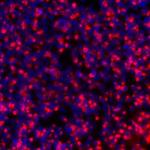
Karen P. Usdin, Ph.D.
Senior Investigator
Laboratory of Cell & Molecular Biology
NIDDK
Research Topics
Short tandem repeat (STR) tracts or microsatellites make up ~8% of the human genome. Small changes in the number of repeats in some of these STRs can predispose to disease or act as a disease modifier. For example, smaller than normal numbers of CAG repeats in the androgen receptor are associated with increased risk of prostate cancer, while larger repeat numbers are associated with androgen insensitivity. In addition, large increases or expansions in the size of some individual STRs are responsible for >50 human genetic disorders known collectively as the Repeat Expansion Diseases (REDs). Most of the REDs are severely life-limiting and have no effective treatment or cure. Work in a number of labs including mine are consistent with the idea that these diseases share a common mutational mechanism. This raises the possibility that drugs that block this mutation may be therapeutical beneficial for many diseases in this group. However, a better understanding of the mechanism responsible is needed in order to maximize the chances of identifying the best drug target. The pathological consequences of expansion for many of these diseases in this group are also still largely unknown. My lab is interested both in the molecular basis of the unusual mutation responsible for these disorders and in the downstream consequences of this mutation. By identifying the pathways involved in disease pathology, we hope to develop rational approaches to treating these disorders and other disorders like them.
To address these questions we take a broad-based approach to study several different REDs. Diseases we study include a neurodegenerative disorder known as fragile X–associated tremor/ataxia syndrome (FXTAS), a form of female infertility known as Fragile X–associated primary ovarian insufficiency (FXPOI) and the most common monogenic cause of intellectual disability (ID) and autism, Fragile X Syndrome (FXS). In addition to ID and autism, FXS is also associated with a folate-sensitive fragile site coincident with the expansion. Fragile sites are prone to breakage in vivo and coincide with deletion or translocation breakpoints in several malignancies. These diseases are known collectively as the Fragile X or FMR1-related disorders, and all result from expansion of a CGG-repeat tract in the FMR1 gene. We also study Huntington’s Disease (HD), an autosomal dominant CAG-repeat expansion disorder associated with uncontrollable dance-like movements (chorea), as well as behavioral changes and cognitive decline; Friedreich’s ataxia (FRDA), an early onset autosomal recessive GAA-repeat expansion disorder associated with loss of mobility, diabetes and hypertrophic cardiomyopathy, and Glutaminase Deficiency Disorder (GLSD), a CAG-repeat expansion disorder, associated with developmental delay, progressive ataxia and refractory seizures. Interestingly, while we have shown that in GLSD, the GLS gene is transcriptionally repressed, recent data suggests that individuals with large GLS repeats that do not show this repression are at elevated risk of kidney and liver disease. In addition to their relevance to human health, these diseases provide a window into critical processes such as the preservation of genome stability, chromosome structure and epigenetics, as well as events that are important for brain, kidney, liver, pancreas and ovarian function.
We are using several different approaches to understanding these diseases including in vitro biochemistry and studies of various patient cell and animal models often using CRISPR technology to make mutations in genes of interest. Our work has demonstrated that the expansion mutation results from the novel interaction of multiple proteins normally involved in mismatch repair (MMR), a DNA repair pathway that protects against many kinds of cancer. Interestingly, recent genome-wide association studies have implicated some of these same factors as important modifiers of age at onset and disease severity in a number of REDs. These findings suggest possible drug targets for delaying the age of onset in those diseases like HD where somatic expansion contributes to a high disease burden and early mortality. However, just how these MMR proteins that normally protect the genome against mutations, end up causing them is unclear. Our current work is aimed at gaining a better understanding of the key steps in this process and identifying good targets for therapeutic intervention.
We are also trying to understand the molecular mechanism responsible for the repeat-mediated epigenetic silencing that is seen in many of these disorders. We have shown that the transcript of the FMR1 gene plays a key role in the FMR1 gene silencing that causes FXS by recruiting the Polycomb Repressive Complex 2 (PRC2). Furthermore, we have shown that small molecules that interfere with recruitment of PRC2 or that inhibit the enzymatic activity of this complex can prevent gene silencing. Our data suggests that it may be possible to develop gene-specific treatments for the epigenetic abnormality responsible for FXS. Our recent work has also shown that a subset of heterochromatic modifications associated with the expanded repeat are not involved in gene silencing as we expected. Instead, they act to prevent chromosome fragility and other events likely to threaten genome integrity. We hypothesize that these threats result from the propensity of the FX repeats to form stable blocks to DNA replication, as we demonstrated in vitro many years ago. Transcription would likely exacerbate any problem associated with replication fork progression, raising the possibility that FX gene silencing occurs in response to the resultant increased replication stress.
We are also interested in developing better tools for diagnosis and research. To this end we have recently developed a package of robust, cost-effective, and sensitive diagnostic assays for these diseases that are suitable for use both in the laboratory and clinic. We are using these techniques to better understand factors affecting the clinical presentation in fragile X families. We are also working with collaborators around the world to identify additional new Repeat Expansion Diseases and to develop assays suitable for diagnosing a variety of newly identified diseases in this group.
Biography
- Scientific Advisory Board of the National Fragile X Foundation
- Co-chair NIH DNA Repair Interest Group
- Editorial Board NAR Molecular Medicine
Selected Publications
- Hayward B, Kumari D, Santra S, van Karnebeek CDM, van Kuilenburg ABP, Usdin K. All three MutL complexes are required for repeat expansion in a human stem cell model of CAG-repeat expansion mediated glutaminase deficiency. Sci Rep. 2024;14(1):13772.
- Zhao X, Lu H, Usdin K. FAN1's protection against CGG repeat expansion requires its nuclease activity and is FANCD2-independent. Nucleic Acids Res. 2021;49(20):11643-11652.
- van Kuilenburg ABP, Tarailo-Graovac M, Richmond PA, Drögemöller BI, Pouladi MA, Leen R, Brand-Arzamendi K, Dobritzsch D, Dolzhenko E, Eberle MA, Hayward B, Jones MJ, Karbassi F, Kobor MS, Koster J, Kumari D, Li M, MacIsaac J, McDonald C, Meijer J, Nguyen C, Rajan-Babu IS, Scherer SW, Sim B, Trost B, Tseng LA, Turkenburg M, van Vugt JJFA, Veldink JH, Walia JS, Wang Y, van Weeghel M, Wright GEB, Xu X, Yuen RKC, Zhang J, Ross CJ, Wasserman WW, Geraghty MT, Santra S, Wanders RJA, Wen XY, Waterham HR, Usdin K, van Karnebeek CDM. Glutaminase Deficiency Caused by Short Tandem Repeat Expansion in GLS. N Engl J Med. 2019;380(15):1433-1441.
- Hayward BE, Usdin K. Improved Assays for AGG Interruptions in Fragile X Premutation Carriers. J Mol Diagn. 2017;19(6):828-835.
- Kumari D, Usdin K. Polycomb group complexes are recruited to reactivated FMR1 alleles in Fragile X syndrome in response to FMR1 transcription. Hum Mol Genet. 2014;23(24):6575-83.
Related Scientific Focus Areas



Molecular Biology and Biochemistry
View additional Principal Investigators in Molecular Biology and Biochemistry


This page was last updated on Thursday, August 14, 2025